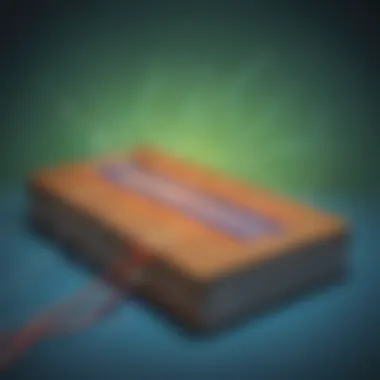Unveiling the Enigmatic Realm of Electricity: A Comprehensive Guide for Young Science Enthusiasts


Science Fun Facts
Electricity is an electrifying force of nature that powers the world around us. Did you know that lightning is a natural form of electricity caused by the build-up of electrical charges in clouds? This phenomenon can be both beautiful and powerful, striking the Earth with immense energy. Understanding the basics of electricity can help us comprehend the mysteries that shroud this fascinating force. Stay tuned as we unravel more fun facts about electricity!
Discover the Wonders of Science
In this section, we will delve into various scientific concepts related to electricity. Through educational videos and animations, young readers will have the opportunity to visualize the flow of electrons and how electrical circuits work. Additionally, interactive learning tools will make understanding electricity engaging and accessible. Real-life applications of science will showcase how electricity powers our homes, schools, and entire cities, making it a vital component of modern life.
Science Quiz Time
Get ready for an electrifying ride with our interactive quizzes focusing on electricity! Test your knowledge with multiple-choice questions that challenge your understanding of circuits, conductors, and insulators. Brain teasers and puzzles will keep you on your toes as you explore the intricacies of electrical phenomena. Learning through gamification will make mastering the principles of electricity a fun and rewarding experience.
Science Experiment Showcase
Embark on a thrilling journey of hands-on exploration with fun and engaging experiments involving electricity. Follow step-by-step instructions to create static electricity, build simple circuits, and observe the effects of electrical charges. A detailed materials list will guide you in gathering everything you need for the experiments. Remember to prioritize safety by following the provided safety tips and precautions to ensure a secure and educational scientific experience.
Introduction to Electricity
In the domain of science and discovery, the fascination with electricity is profound and enduring. Expressly crafted for young minds aged 6-12, this article embarks on a journey delving into the foundational elements and applications of electrical currents. By initiating an exploration centered on the enigmatic realm of electricity, we aim to ignite a spark of curiosity that will cultivate a deeper understanding of this omnipresent force in the natural world.
What is Electricity?
Defined at its core, electricity is the flow of electric charge. It is a fundamental concept that permeates various aspects of modern living, from providing light in our homes to enabling the functionalities of our electronic devices. Understanding the essence of electricity entails grasping the movement of electrons through conductive materials, manifesting as power for a multitude of applications.
History of Electricity
The historical narrative of electricity traces back through the annals of scientific progress, from the pioneering experiments of Benjamin Franklin to the groundbreaking discoveries of Michael Faraday. Each pivotal moment in history has contributed to our current comprehension and utilization of electrical phenomena, paving the way for the technological advancements that define our era.


Importance of Electricity in Our Lives
In contemplating the significance of electricity in contemporary society, one must acknowledge its indispensable role in sustaining our daily routines and facilitating progress across diverse industries. From powering urban infrastructure to fueling scientific innovation, electricity stands as a linchpin that drives modern civilization forward with unparalleled efficacy.
Key Concepts in Electricity
To navigate the complexities of electricity, familiarity with key concepts is paramount. Voltage, current, and resistance form the triad of principles that govern electrical systems, delineating the dynamics of energy transfer and distribution. Mastery of these fundamental tenets equips individuals with the groundwork necessary to comprehend and engage with the intricate world of electrical engineering.
Understanding Electrical Circuits
Understanding Electrical Circuits plays a pivotal role in elucidating the intricate workings of electricity. Amidst the array of scientific concepts covered in this article, delving into Electrical Circuits unveils the core mechanisms that drive the flow of electricity with precision and efficiency. By exploring the Components of an Electrical Circuit, readers are introduced to Voltage, Current, and Resistance - fundamental elements that shape the foundation of electrical systems, setting the stage for a comprehensive comprehension of this fundamental force of nature.
Components of an Electrical Circuit
Voltage
Voltage, a quintessential aspect of Electrical Circuits, represents the driving force behind the flow of electrical current. In the context of this article, Voltage serves as a cornerstone in elucidating the behavior of electricity within circuits. Its key attribute lies in its ability to create potential difference, compelling electrons to move along a pathway. Moreover, Voltage's potency in instigating the flow of electrons renders it a crucial element in powering various electrical devices, making it a favorable subject for discussion within this educational narrative. However, variations in Voltage levels can introduce complexities, necessitating a nuanced understanding of its advantages and drawbacks within the realm of Electrical Circuits.
Current
Conversely, Current embodies the actual movement of electric charge within a circuit, showcasing the dynamic aspect of Electricity. Within the context of this article, Current emerges as a vital protagonist in illustrating how electrons traverse through a circuit, carrying energy and enabling the operation of electrical appliances. Its distinguishable trait lies in its ability to quantify the rate of charge flow, shedding light on the intensity of electrical activity within a given system. While viewed as a vital component in understanding Electrical Circuits, delving into Current's attributes uncovers a spectrum of advantages and disadvantages that merit exploration in this enlightenment journey.
Resistance
Resistance, an indispensable factor in Electrical Circuits, acts as an impediment to the flow of electrical current, introducing a crucial element of control within systems. Exploring Resistance within the context of this article unveils its pivotal role in regulating the movement of electrons, thereby influencing the overall performance of circuits. Its notable characteristic lies in its capacity to dissipate energy in the form of heat, offering a means of managing electricity flow effectively. By scrutinizing the unique features of Resistance, readers can appreciate its intricacies and implications, underscoring its role within the broader spectrum of Electrical Circuits.
Electricity and Magnetism


Electricity and magnetism stand as crucial pillars in the realm of science. In this illuminating article, the focus shifts towards understanding the intricate relationship between these two fundamental forces of nature. Electricity courses through our modern lives like a hidden power, often overlooked in its omnipresence. Magnetism, on the other hand, exerts a magnetic pull on our curiosity, pulling us towards marvels of innovation and discovery. Uniting these forces unravels a synergy that drives technological advancements and fuels our quest for knowledge.
Electromagnetic Relationship
The electromagnetic relationship weaves a mesmerizing tapestry of interconnected phenomena. At the core lies the concept of electromagnetic fields, a pervasive force that governs the behavior of charged particles. Through this relationship, electricity emerges as a manifestation of the movement of charged particles, while magnetism demonstrates its magnetic allure through the alignment of magnetic fields. Delving deeper, one uncovers the intricate dance of electromagnetic waves that propagate invisibly yet powerfully through space, laying the foundation for communication, energy transmission, and a myriad of technological marvels.
Applications of Electromagnetism
Electric Motors
Electric motors epitomize the epitome of electromagnetism's practical applications within this article. These ingenious devices transform electrical energy into mechanical motion, driving a multitude of everyday appliances and machinery. The fundamental principle behind electric motors lies in the interaction between magnetic fields and electric currents, generating rotational force essential for powering everything from industrial machinery to household gadgets. Their efficiency, reliability, and versatility render electric motors a cornerstone of modern technology, revolutionizing industries and shaping the landscape of automation.
Generators
Generators stand as stalwarts of electrical power generation, embodying the essence of electromagnetism in action. These devices operate on the principle of electromagnetic induction, converting mechanical energy into electrical energy with remarkable efficiency. By harnessing the interplay between magnetic fields and induced currents, generators serve as vital sources of electricity across various sectors, from powering homes during outages to supporting large-scale industrial operations. The ability to produce electricity on demand makes generators indispensable in ensuring a reliable and sustainable power supply, illustrating the enduring significance of electromagnetism in shaping our electrified world.
Renewable Energy Sources
Renewable energy sources play a pivotal role in shaping our future. In the realm of this article, understanding the significance of renewable energy sources is paramount. These sources, such as solar power, wind energy, and hydropower, offer sustainable solutions to our energy needs while reducing environmental impact. By exploring these alternative energy sources, young science enthusiasts can grasp the importance of moving towards cleaner and more efficient power generation methods. Renewable energy sources not only showcase technological advancements but also emphasize the crucial shift towards a greener and more sustainable future.
Harnessing Electricity from Renewable Sources
Solar Power
Solar power stands out as a prominent renewable energy source in our modern world. Its ability to harness the energy from the sun and convert it into electricity makes it a key player in the renewable energy sector. Solar power's clean and abundant nature positions it as a frontrunner in the quest for sustainable energy solutions. The essence of solar power lies in its photovoltaic cells, which capture sunlight and transform it into usable electrical energy. This environmentally friendly feature makes solar power a compelling choice for energy production in this article. Although solar power boasts numerous advantages, such as being renewable and low maintenance, it also presents challenges like intermittency and high initial costs. Understanding the intricacies of solar power provides young readers with insights into a greener energy future.


Wind Energy
Wind energy emerges as another vital contributor to renewable energy sources. By harnessing the power of wind through wind turbines, electricity generation becomes possible without relying on finite fossil fuels. The primary characteristic of wind energy revolves around its ability to convert kinetic energy from the wind into electrical power. This sustainable energy source is cost-effective and widely available, making it an attractive option for renewable energy discussions. However, the dependence on wind patterns and potential impact on local wildlife stand as notable considerations when exploring wind energy within this article. Unraveling the potential and challenges of wind energy enriches young minds with a profound understanding of our energy ecosystem.
Hydropower
Hydropower offers a longstanding history of generating electricity through water flow, showcasing its efficiency and reliability as a renewable energy source. Its key characteristic lies in utilizing the kinetic energy of moving water to produce electricity, contributing significantly to our clean energy goals. Hydropower's renewable nature and ability to store energy for peak demand make it a favored choice for sustainable power generation in this article. Despite its advantages in emission reduction and energy stability, hydropower faces drawbacks related to ecological disruption and limited suitable locations for large-scale installations. Analyzing the dynamics of hydropower introduces young readers to the complexities of balancing energy needs with environmental conservation.
Benefits of Renewable Energy
The benefits of embracing renewable energy sources are manifold and far-reaching. Transitioning towards sustainable power options not only mitigates environmental harm but also promotes energy independence and security. By harnessing renewable sources like solar power, wind energy, and hydropower, communities can reduce greenhouse gas emissions and combat climate change effectively. Furthermore, the decentralized nature of renewable energy empowers local economies and fosters innovation in clean technologies. Educating young minds on the benefits of renewable energy instills a sense of responsibility towards energy consumption and environmental stewardship, paving the way for a brighter and greener tomorrow.
Electrifying Experiments for Young Scientists
Electrifying Experiments for Young Scientists is an indispensable section in this comprehensive guide on electricity dynamics. For young minds eager to explore the wonders of science, engaging in hands-on experiments is paramount. These experiments serve as portals to demystifying complex concepts and fostering a deep love for scientific inquiry. By immersing themselves in practical activities like creating a Lemon Battery and Building a Simple Circuit, children can grasp fundamental principles in a tangible and memorable manner. Such experiences not only kindle curiosity but also nurture critical thinking skills and a passion for experimentation.
Simple Electrical Experiments
- Creating a Lemon Battery
Creating a Lemon Battery
Creating a Lemon Battery is a pivotal experiment that bridges theory with practice in an accessible and captivating way. This experiment involves harnessing the acidic properties of a lemon to generate a small electrical charge, offering a glimpse into the transformative power of chemical reactions in electricity generation. The key allure of Creating a Lemon Battery lies in its simplicity and affordability, making it an ideal choice for inquisitive young scientists. One prominent characteristic of this experiment is its ability to demonstrate the basic concept of electrical conductivity using easily obtainable materials. Despite its simplicity, Creating a Lemon Battery provides a profound insight into the connection between chemical components and electrical energy, laying a strong foundation for further exploration.
- Building a Simple Circuit
Building a Simple Circuit
Building a Simple Circuit stands as a cornerstone in understanding the operational mechanism of electrical systems. This experiment enables learners to construct a basic circuit using components like wires, batteries, and light bulbs, illustrating the continuous flow of electricity in a closed loop. The primary advantage of Building a Simple Circuit lies in its hands-on approach, allowing participants to visually comprehend how electricity moves within a circuit and illuminates a connected bulb. A unique feature of this experiment is its capacity to demonstrate the relationship between voltage, current, and resistance in a practical setting, enhancing comprehension and retention. While Building a Simple Circuit may pose minimal risks, such as short circuits, the benefits of hands-on learning and real-time engagement far outweigh any potential drawbacks.
Safety Tips for Conducting Electrical Experiments
Ensuring the safety of young scientists during electrical experiments is paramount to a successful and enriching learning experience. Before embarking on any hands-on activities, it is essential to educate participants on basic safety protocols, including the proper handling of electrical components and equipment. Emphasizing the importance of adult supervision and following established guidelines can mitigate potential risks and accidents. Furthermore, incorporating safety measures such as wearing protective gear, working in well-ventilated areas, and unplugging sources when not in use can create a secure environment for experimentation. By instilling a culture of safety consciousness early on, young scientists can explore the captivating world of electricity with confidence and responsibility.







